
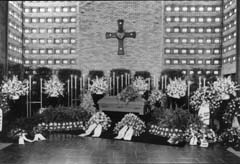
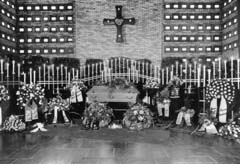
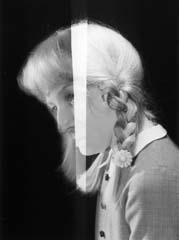
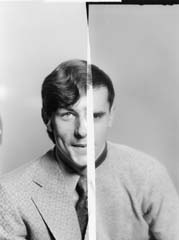
There is a long and interesting history behind the use of found photographs in art. People reached for other people's photographs for various reasons and in connection with very different artistic phenomena - because the authors who have found "artistic" use for someone else's photographs are very different artists. First there are those who treat found photographs as food for analyses and reflection upon the nature of the imagery of the medium. Their approach was shaped by the tendencies of conceptual art which to a large degree was a theoretical meta-reflection on some of the most fundamental questions, including the image itself and how it functions. Others use found photographs as ready-mades or initially transformed visual material which forms the material part of their own work. For those artists the image contained in found photographs is significant, but only as a part of often complicated image structures and contents, like photomontage. In both cases what is less important, and sometimes simply insignificant, is the private, "personal" content, connected with each picture's past. This private, "personal" content is the result of the intention of the person who took the photograph and the intention of the person to whom it belonged. It is the owner of photographs who gives them their opulent content, rather unattainable for other people. But there are also artists who base the message of their works, founded visually on other people's pictures, precisely on their "personal" content. They use them to create their own, equally personal content, and they can strongly affect the viewers' emotions. Finally, there are those who use other people's photographs for more complicated projects, like games with time, image, memory and space. They transform and reconstruct found photographs to such a degree that they give them completely new meanings and content. Some artists, though, take interest in the phenomena of found photographs themselves. They try to recall the presence of what they represent or to impose order on the vastness of the photographic legacy. Alexander Honory and Joachim Schmid belong to this last group of artists. They are discoverers, explorers, collectors and - in a specific way - the users of rejected photography. Their projects partly restore lost functions or give new ones to found photographs.
Ever since it came into existence, photography has had a private and personal character - it was a precious token of remembrance of the deceased or gone and it was a form of illusory contact with the absent. Photography was successful exactly because it was capable of registering the human figure and representing it within the image. It became popular and gained practical meaning only when it became technically possible for it to register a satisfactory, individualized image of man. Not being just a technical invention any more it became an important part of public visual culture as well as of the private sphere of individual our lives.
What makes photographers and other image-creators reach for other people's photographs? The reason is not convenience or laziness. The toil of gathering, selecting, editing and presenting found material is comparable to the toil of taking new photographs, or perhaps even harder. Schmid and Honory have accumulated large collections of photographs. Their gathering passion echoes a certain general aspect of photography. Every photographer, every viewer and everyone who experiences the world visually is a gatherer of images. Photography, in a different sense that we commonly believe, means, among other things, gathering of images. Their old and current status, origin and function may be quite different - because, for a large part, we gain our sensual experience of the world and the knowledge of it from the images which come into being in our minds, and from already existing images, i.e., for example, photographs.
Joachim Schmid and Alexander Honory gather mainly amateur, private and family photographs. One can hardly find something more conventional, banal and similar in photography than family photographs, which is true both for amateur and studio pictures. Those are unassuming images, yet we collect them with great eagerness and feeling not always realizing why we do it. When asked why, we answer "in remembrance". But what is a "remembrance"? Is it pure memory or a simple amplification of fallible memory? Or does it relieve our memory from retaining the images of our kin and us from many years ago? Or is it something more complicated, like an attempt to recall times definitely past? Or perhaps the image becomes the form of recalling not time and people's facial features, but their presence? For each photographic image retains a moment, a fraction of the past in which the photograph was taken, when the shutter opened. It is the record of that time and that situation which was different before the picture was taken and immediately after. This leads us to the phenomenon of the presence of those photographed in the picture, and to a large degree this is how Schmid and Honory use the photographs from their collections. Otherwise their archivistic and creative moves would not be able to move us - their public. Joachim Schmid gathers photographs in order to grasp those phenomena which are the result of the vast and mass numbers in which photographs exist. A separate picture and its hero is not a value or an aim for him - it is rather a whole set of pictures, their mutual and singular relations as well as their relations with the great number of all other photos of which they are a part. The use he makes of them also refers to those problems. The "Archiv/Archive" project, founded in 1986, serves this purpose, as does the "Bilder von der Strasse/Pictures from the Street" project, started in 1982, and as do his later projects, like "Erste Allgemeine Altfotosammlung/The Institute for the Reprocessing of Used Photographs" (1990) or the "Photographic Garbage Survey Project" (1996).
"Archiv", currently made up of 700 boards pasted with photographs, is an attempt to make the gathered pictures seem more orderly and systematic. The images on each board are usually linked by their content. Setting them in order according to this simple criterion gives us certain knowledge about the types of images functioning in this kind of photography, which are images of standard or conventional content. A similar idea lies behind the "Pictures from the Street". Photographs found in the streets are interesting for Schmid not so much as pictures of concrete people or objects, but because they show what people think is important to have on them and what is unimportant about private images that end their existence in the street as litter. The consequence and development of both these projects are two next ones, and the ones following. "The Institute for the Reprocessing of Used Photographs" (1990) was created as a kind of a provocative gesture at contemporary problems connected with ecology and photography. "'The Institute for the Reprocessing of Used Photographs' was originally nothing but an ironic comment about the mass production of photographs and about superficial attitudes towards serious ecological issues. However, people took it seriously, and I had to do exactly what I had promised in the flyer I produced, which was to recycle photographs. I'm using photographic garbage and turning it into art." After six months of transforming photographs, which Schmid received in great numbers, he had to stop the project because he could not cope with transforming them all.
This project gave rise to the next one, called "Statics" (1995), in which the artist uses narrow strips of photographs cut in a machine used to destroy documents. Schmid created a kind of a photographic collage out of unidentifiable fragments of pictures, pasting strips of photographs next to one another on the whole surface of the board, achieving an almost abstract picture, unreadable as a whole but whose smallest elements are, nevertheless, fragments of realistic photography.
The "Photographic Garbage Survey Project" (1996) is a development of "Pictures from the Street", but the process of its realization was somewhat different. The author was more active and direct in the creation of this gathering. He travelled around the world and wandering around selected cities looked for discarded photographs in the streets. The effect of this search was presented in the form of photographs found in the streets and set against a city map where the places in which they had been found were marked. Each picture is also accompanied by a stamped, filled-out form, containing the description of the circumstances in which the photos were found, and complete with the artist's signature.
Schmid's provocative, sometimes sarcastic or ironic projects are manifestations of a critical approach, camouflaged only by the artist's attempts to stress that his method is neutral and objective. It is not always correctly interpreted and sometimes Schmid is forced to carry out a literal realization of a provocative project of his in order not to go back on his public declarations. What is interesting about it, however, is that he accepts it and tries to carry out faithfully whatever he somewhat hastily and not really seriously declared, creating new situations and challenges which broaden the spectrum and the means of artistic "utilization" of unwanted, rejected photography - photographic garbage. Bearing in mind all his connections with the conceptualism of the 60s and 70s, Joachim Schmid belongs to the tribe of postmodern artists. His projects, although so systematic that nearly scientific, do not explain either single pictures or whole sets of them. They rather prove that such explanations are impossible, that the sense of the images is not hidden in them, in their content, but it is the result of the context in which they appear beside other images or messages. Schmid takes on the attitude of postmodern disbelief in the possibility of understanding individual images of the modern world of visual culture - because the individual image has lost independence in terms of its contents, confronted with masses of other images, and its every interpretation or reading is equally valid as the next one. Thus neither those images nor the world represented by them can be described. In spite of the fact that we may give sense and meaning to details and single elements of the images, the whole conceived as a visual communicative structure does not possess any unambiguous sense.
"I've been working with found/appropriated imagery because I think that basically everything in the world has now been photographed in every possible way. We have an incredible amount of pictures after a hundred years of industrialised image making, so making more picture is no longer a creative challenge. Nevertheless this production of photographs of images goes on, photographs will always be produced. It's not so much the production of photographs which needs to concern us, but the use of them. On one hand, every single photograph represents or depicts a fragment of reality, while on the other, that same photograph is a part of reality, both as a psychical object as an image/symbol. It's much more interesting to use these existing images and work with them than making new photographs because existing photographs not only represent parts of our realities, they are realities. Today's reality is the reality of images."
Alexander Honory in his collection "Privates Institut für Neuzeitliche Familienfotografie/Private Institute of Contemporary Family Photography" seems most interested in single photographs and the images of human beings contained in them, although sometimes they may be images of objects belonging to those people. Honory does not restore the forenames and surnames of the people in his found photographs - he restores their presence, using various forms and methods to this aim. He uses modest show-cases to present the pictures ("Schaukasten", 1990), enlarges single photographs, prints them in books published by the Institute or even transforms them into gigantic light pictures.
The title picture of "Das gefundene Bild/The Found Picture" (1992) was not found in the street. The work is composed of 32 anonymous, colour photographs taken in an unknown studio. They were taken in remembrance of the ceremony of baptism: against a blue background, same in all cases, we see a whole gallery of somewhat similar types as far as their social environment is concerned, but internally, characterologically and physiognomically different. For exhibition purposes the photographs are usually enlarged to superhuman proportions, extraordinary for this type of photography. In this way the people become clearly more individualized. Honory's trick, simple and natural in photography, makes those people be themselves more intensely. The artist seems full of respect towards the people and humbly pays respect to the anonymous authors of the photographs. They tell us about those people what they would tell us themselves when they accepted convention and conformed to it. This usually non-reflexive self-definition and self-description of amateur or studio photographs gives them their natural power which Honory only stresses by means of his subtle creative trick. The privacy of family photographs is realized in a totally different way in his "Dreizehn Hochzeitspaare für Berlin/Thirteen Newlywed Couples for Berlin" (1992). This project is monumental and much more public than earlier endeavours by Honory. In this case anonymous wedding pictures were projected on a huge advertisement light panel in the centre of Berlin. The scale of the images, the place and the way of their presentation, although so remote from privacy and intimacy, did not disrupt the suggestion of intense presence of the people in the photographs. At the most they could cause consternation among the viewers who - at first sight - might have mistaken them for something else: another manifestation of advertising.
A similar confrontation of the private and the public sphere occurs in "Schutzengel für Berlin/Guardian Angel for Berlin" (1992). It was an enormous enlargement (360x240 cm) of a photograph of a little girl after her first communion, hung on the wall of some shabby building in a factory district of Berlin, becoming for the viewer an ambiguous element of the street iconosphere. A series of photographs called "The Last Picture" (1995) deals with the ultimate questions. The photographs show the indoors of cemetery chapels or funeral homes with coffins set among pretentious decorations, covering those who will be bidden farewell just before leaving on their last journey. Each picture shows elements of different ceremonies in the honour of the different deceased. However, the repeated convention of the photographic form and decorations points to the only individualistic elements of the pictures, namely to petty variations in the appearance of the coffins. In this way Honory closes the circle of the description of life by means of private, family photographs in which the individual remains the main object of his interest even when the image of the person in question is not there. We have to do with another kind of privacy in "Raum mit Photos/Space with Photographs" (first presented in 1992). The work is composed of 138 anonymous amateur pictures in silvery frames. In galleries or private homes they are installed on walls like home photographs, in large clusters, close to one another, without marking any kind of hierarchy of their significance. Each picture is described briefly, in "catalogue" manner, explaining what or whom it represents. The author's gesture gives those photographs a primal sense, putting them together in situations resembling their "natural" environment.
An original follow-up of the previous work is "The Lost Pictures" (1994/95). There are no images in this work, only laconic descriptions which list objects represented in lost pictures. The description of the object becomes the only confirmation of its existence. At exhibitions the wire-framed description represents the picture which used to be a representation of people and objects. Paradoxically, because the work is devoid of photography, the sense of the existence of the Institute is revealed, since the Institute's object of interest is photography. It is not the photographs themselves that are cared for here, but their content, the memory of people and the way it is preserved in family photographs. In these last two works we can see an interesting relation between an image and its description. The description comes to the aid of the image which - in spite of the material nature of photographic registration - seems transitory and not durable enough as far as his message is concerned. It is the word that gives durability to the contents of the images. A picture described becomes a permanent element of history even if the description is no more than an inventory of what is in the picture - it is the word that gives it meaning and durability. One could interpret this as Honory's disbelief in the power of photography - because although he is a photographer himself, he seems to believe that photography is unable to describe what the images really represent.
Alexander Honory's collector's passion can be also seen in his own photographic projects. Since 1996 he has been engaged in a great project, both on the quantitative and geographical scale, entitled "One World with Many Faces". He has accumulated tons of documentary material photographying people in a single mode - taking a close-up of the face and a shot from straight ahead. In this way Honory creates a collection of people's images which retains their individual presence in the picture. The pictures of this collection do not describe differences resulting from manners or cultural and social conditions. Using the simplest photographic form, their author is trying to show the similarity between those very different individuals, as well as some things they have in common - while forcing the viewers at least to take the momentary trouble to stop and look, try to identify the person, reflect for a second on the individual existence of each of these people, who, or rather their photographic representations, in turn look at us inquisitively and attentively from the pictures.
In the projects of Schmid and Honory there is a double meaning of artistic transformation, or the recycling of found pictures: the first is physical, the other "spiritual", symbolic, semantic and functional. The common feature of the works of both authors and of both collections is the fact that they restore the meanings and functions lost by forgetfulness and "moral wear" to photographs which have never ceased to be photographs. In the result of their manipulations a photograph undergoes a deep metamorphosis. When it leaves the collection it is something different than when it was included in it. Both artists attempt to cultivate, organize and control a part of the great mass of photographs which our visual culture has produced and still produces. Schmid wants not only to set them in order and classify them, but also to submit them to critical judgment as something that is already "controlled" intellectually. Honory adopts another strategy. The critical element in his projects is reduced only to the process of selection which is not ruled by any arbitrary criteria. He is not concerned so much with theoretical or critical questions as with the human, personal, though anonymous aspect of his works. His method is also based on certain aesthetic manipulations of found photographs, like enlargement, framing etc., which only serve to underline the content of the picture and bring out the clarity of man's image. Schmid's attitude is more impersonal and scientistic. In his case art is combined with a quasi-scientific method whose author and user at the same time cannot refrain from non-scientific, sometimes sarcastic and ironic gestures.
In spite of these differences both artists restore usefulness and the function of representation of individual human beings to discarded photographs, containing usually images of man and doomed for destruction. Thus old pictures may still be important, they may still serve to ignite emotions and provoke reflection upon permanence and transitoriness, upon the individual and the common, the universal and the particular. Saving photographs of anonymous people from physical destruction, the collections of Schmid and Honory in a certain sense also save those people from oblivion. They restore the sense and function to pictures doomed for destructiom and symbolically restore the presence of people represented in them. No picture is a separate entity, as it came into being because of man and is usually devoted to him. Someone took it, possesed it, discarded it for some reason or lost it and only then did it enter a collection. A found photograph is a piece of evidence of individual existence in a many senses, including the existence of the author of the photograph, the existence of the object of the photograph, and the existence of its owner. Those photographs are re-used in such a way that they cannot be compared with used beer cans, old newspapers and worn-out clothes.
Moreover, discarded and found photographs used to belong to the community in which they came into being. And they still belong there because of their conventional imagery, the common behavioural, religious and ritualistic conventions, represented in the pictures, and because of the image of the people who used to make up or make up a given community. Even if today those pictures cannot tell us much about the author, except his name, or about the people in them, except their facial features and traces of personality (preserved even in most conventional photography), they can tell us a lot - and this is their paradoxical and eternal value - about the community that they also represent. Every time someone restores them to usefulness by the simple act of perception and inclusion into the circle of contemporary visual culture, they are also restored to our common memory on many levels: on the level of reality, on the physical and material level, as well as on levels metaphoric and symbolic.
Maj 2001, Lech Lechowicz
Translated by Maciej Świerkocki 


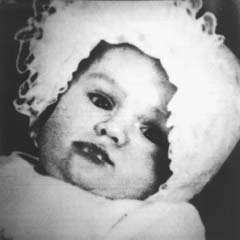
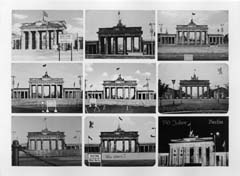
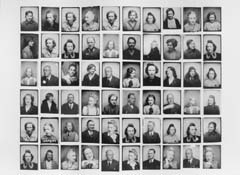

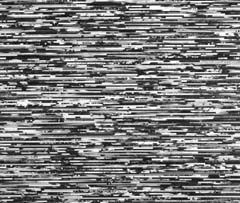
(courtesy San Francisco Museum of Modern Art)